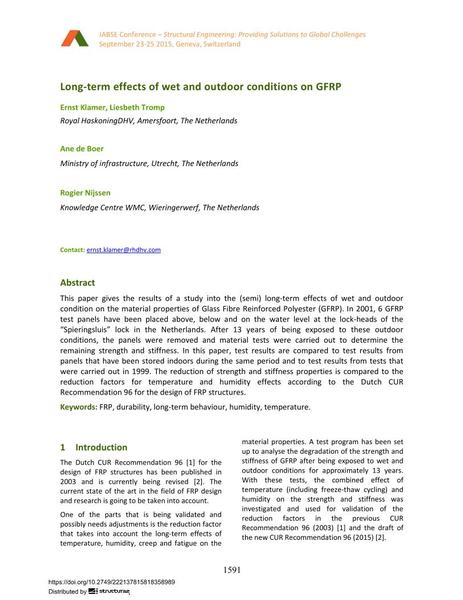Long-term effects of wet and outdoor conditions on GFRP

|
|
|||||||||||
Bibliografische Angaben
| Autor(en): |
Ernst Klamer
(Royal HaskoningDHV, Amersfoort, The Netherlands)
Liesbeth Tromp (Royal HaskoningDHV, Amersfoort, The Netherlands) Ane Boer (Ministry of infrastructure, Utrecht, The Netherlands) Rogier Nijssen (Knowledge Centre WMC, Wieringerwerf, The Netherlands) |
||||
|---|---|---|---|---|---|
| Medium: | Tagungsbeitrag | ||||
| Sprache(n): | Englisch | ||||
| Tagung: | IABSE Conference: Structural Engineering: Providing Solutions to Global Challenges, Geneva, Switzerland, September 2015 | ||||
| Veröffentlicht in: | IABSE Conference Geneva 2015 | ||||
|
|||||
| Seite(n): | 1591-1598 | ||||
| Anzahl der Seiten (im PDF): | 8 | ||||
| Jahr: | 2015 | ||||
| DOI: | 10.2749/222137815818358989 | ||||
| Abstrakt: |
This paper gives the results of a study into the (semi) long-term effects of wet and outdoor condition on the material properties of Glass Fibre Reinforced Polyester (GFRP). In 2001, 6 GFRP test panels have been placed above, below and on the water level at the lock-heads of the “Spieringsluis” lock in the Netherlands. After 13 years of being exposed to these outdoor conditions, the panels were removed and material tests were carried out to determine the remaining strength and stiffness. In this paper, test results are compared to test results from panels that have been stored indoors during the same period and to test results from tests that were carried out in 1999. The reduction of strength and stiffness properties is compared to the reduction factors for temperature and humidity effects according to the Dutch CUR Recommendation 96 for the design of FRP structures. |
||||
| Stichwörter: |
Dauerhaftigkeit CFK Temperatur Luftfeuchtigkeit
|
||||
